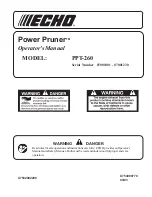
www.scheppach.com /
+(49)-08223-4002-99 /
+(49)-08223-4002-58
30 | GB
9 Handle insertion tool with caution. They are ide-
ally stored in the originally package or special
containers. Wear protective gloves in order to im-
prove grip and to further reduce the risk of injury.
10 Prior to the use of insertion tools, make sure that
all protective devices are properly fastened.
11 Prior to use, make sure that the insertion tool
meets the technical requirements of this electric
tool and is properly fastened.
12 Only use the supplied saw blade for sawing oper-
ations in wood, materials similar to wood, plastics
and non-ferrous metals (except for magnesium
and alloys containing magnesium).
13. Use the saw blade intended for the material to be
processed.
14. Use only a saw blade with a diameter that match-
es the specifications on the saw.
15. Use only saw blades that are marked with an
equal or higher rotational speed than that marked
on the power tool.
16. Use only saw blades recommended by the manu-
facturer which conform to EN 847-1, if intended for
cutting wood or similar materials.
17. Wear suitable personal protective equipment,
such as:
– hearing protection;
– protective gloves when handling saw blades.
18. Use only saw blades recommended by the manu-
facturer which conform to EN 847-1. Warning!
When changing the saw blade, make sure that the
cutting width is not smaller and the thickness of
the saw blade is not greater than the thickness of
the splitter.
19. When sawing wood and plastics, avoid overheat-
ing the saw teeth. Reduce the feed speed to avoid
the plastic melting.
Residual risks
The machine has been built according to the
state of the art and the recognised technical
safety requirements. However, individual residu-
al risks can arise during operation.
• Health hazard due to electrical power, with the use
of improper electrical connection cables.
• Furthermore, despite all precautions having been
met, some non-obvious residual risks may still re-
main.
• Residual risks can be minimised if the „safety in-
structions“ and the „Proper use“ are observed
along with the whole of the operating instructions.
• Do not load the machine unnecessarily: excessive
pressure when sawing will quickly damage the saw
blade, which results in reduced output of the ma-
chine in the processing and in cut precision.
c)
Set up the circular table saw in a location that
is level and well ventilated, and where it can
stand safely and remain balanced. The instal-
lation site must provide sufficient space for
easily handling the size of your workpieces.
Disorganised and unlit working areas, and un-
even, slippery floors may lead to accidents.
d)
Regularly remove chips and sawdust from be
-
neath the saw table and/or from the dust ex-
traction system.
Accumulated sawdust is flam
-
mable and can self-ignite.
e) Secure the circular table saw.
If a circular table
saw is not secured correctly, it can move or topple.
f)
Remove the adjustment tools, wood residues,
etc. from the circular table saw before switch-
ing it on.
Deflections and possible jams could be
dangerous.
g) Always use the right size of saw blade and
an appropriate location hole (e.g. diamond-
shaped or round).
Saw blades that do not fit with
the mounting parts of the saw will run out-of-centre
and result in a loss of control.
h) Never use damaged or incorrect saw blade
mounting materials, such as flanges, washers,
screws or nuts.
These saw blade mounting ma-
terials have been specially designed for your saw,
for optimum performance and operational safety.
i) Never stand on the circular table saw and do
not use it as a step stool.
Serious injuries can
arise if the electric tool topples or if you acciden-
tally come into contact with the saw blade.
j)
Make sure that the saw blade is mounted in the
correct direction of rotation. Do not use grind-
ing discs or wire brushes with the circular ta-
ble saw.
Incorrect assembly of the saw blade or
the use of accessories that have not been recom-
mended can result in serious injuries.
Safety instructions for the handling of saw blades
1 Only use insertion tools if you have mastered
their use.
2 Observe the maximum speed. The maximum
speed specified on the insertion tool may not be
exceeded. If specified, observe the speed range.
3 Observe the motor / saw blade direction of rota-
tion.
4 Do not use any insertion tools with cracks. Sort
out cracked insertion tools. Repairs are not per-
mitted.
5
Clean grease, oil and water off of the clamping
surfaces.
6 Do not use any loose reducing rings or bushes
for the reducing of holes on saw blades.
7
Make sure that fixed reducer rings for securing
the insertion tool have the same diameter and
have at least 1/3 of the cutting diameter.
8
Make sure that fixed reducer rings are parallel
to each other.
Содержание 5901310901
Страница 6: ...www scheppach com service scheppach com 49 08223 4002 99 49 08223 4002 58 6 23...
Страница 278: ...www scheppach com service scheppach com 49 08223 4002 99 49 08223 4002 58 278...
Страница 280: ...www scheppach com service scheppach com 49 08223 4002 99 49 08223 4002 58 280...
Страница 281: ...www scheppach com service scheppach com 49 08223 4002 99 49 08223 4002 58 281...
















































